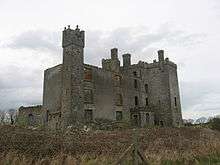Athcarne Castle
Athcarne Castle is a ruined Elizabethan castle outside the town of Duleek in County Meath, Ireland.

The name Athcarne is thought to be derived from either Ath Cairn meaning the Bridge, or Fording Point at the Cairn, or burial mound, or alternatively from Ard Cairn, meaning High Cairn. There is a burial mound to the south east of the castle, across the Hurley river. Beryl Moore, the historian, wrote that the castle may actually be built on top of a cairn. These cairns were built around 4,000 years ago. In 861, the Vikings raided Newgrange and Moore wrote that the Cairn/s at Athcarne were also raided at that time.
In 1172, the lands at Athcarne were granted to the Anglo-Norman knight Hugo De Bathe, who came from Bath in England. He arrived in Ireland, either with Richard, Earl of Pembroke ("Strongbow") in 1170 or with Hugh de Lacy, Lord of Meath in 1171. It is likely that he built a defensive structure on the site which evolved into a tower house over the next few hundred years. It was significantly extended in 1590 by the senior judge Sir William Bathe and his wife Janet Dowdall. On Sir William's death in 1597 it passed to his brother James Bathe, and then to James's heirs: James Bathe, who owned Athcarne in the 1640s, was probably the first James's grandson.
On 1-2 September 1649, Oliver Cromwell, facing a rebel army advancing from the north, gave the order to capture three castles near the crucial crossing points on the river Nanny, and hence strategically important: they were Athcarne, Bellewstown and Dardistown Castles.
Following its capture, Athcarne was granted to a Colonel Grace, one of Cromwell's officers. James Bathe and his family then moved to Ashbourne. James Bathe died sometime before 1660. His son, Luke Bathe, continued lobbying the Crown for return of their estates. Despite petitioning to get his lands back, under the Second Act of Settlement 1662, Athcarne, as well as many of the estates originally taken by Cromwell were transferred into the name of the Duke of York, the future King James II of England. The Bathe family never regained ownership of Athcarne. In 1668, The Duke of York allowed Sir Luke Bathe to rent Athcarne and 1,200 acres from him on a 99 year lease from 1668 for £430 in total, considered a "pepper-corn" or nominal amount at the time. This lease expired in 1767. However, the future King kept all the other Bathe estates, Drumcondra, Glasnevin, Ballybough, Balgriffin, Clontarf,and Baldoyle, all in County Dublin, and Laudenstown in County Kildare, besides valuable other property in Dublin city and Drogheda.
Of many legends about the Castle, which is said to be haunted, the most plausible is that King James II slept here on his way to the Battle of the Boyne in 1690, the Castle being only six miles from the battlefield. In fact, James II actually owned Athcarne at the time and the Bathe family were simply renting it from him on a long lease (see paragraph above).
The Bathe family eventually left the castle about 1700 and it was owned by the Garnett family for the next 100 years or so. Around 1830, it was bought by the Gernon family who significantly remodelled it, demolishing the Elizabethan mansion house built by William Bathe in 1590 and building a more modern extension. The Gernon family experienced a downturn in fortunes and eventually the Castle was sold at auction in 1939. The Castle was gutted and the parts sold off for architectural salvage. The plan was to demolish the castle and use the rubble to extend roads in the area. This did not happen and eventually what remained of the Castle passed into the care of the Irish State.

References
- Ball, F. Elrington The Judges in Ireland 1221-1921 John Murray London 1926
- D'Alton, John King James' Irish Army List Celtic Bookshop Reprint Limerick 1997
- Dublin Penny Journal 1833 Vol. 1 No. 28
https://www.facebook.com/pages/Athcarne-Castle/1512769065639078?ref=hl Coordinates: 53°37′19″N 6°26′28″W / 53.6220°N 6.4412°W